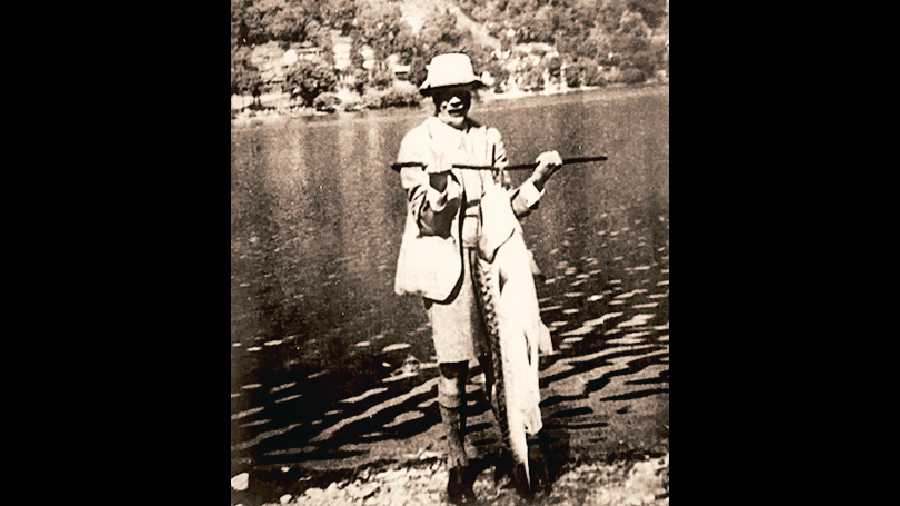Book: The Corbett Papers: Biographical, Legal, & Contextual Material On The Life & Career Of Jim Corbett Of Kumaon
Author: Akshay Shah and Stephen Alter
Publisher: Black Kite
Price: ₹699
The Jim Corbett Omnibus had been published by Karuna Prakashani almost fifty years ago. This volume of Corbett’s writings, translated into Bengali, was one of the most enchanting windows on Corbett — the man and the writer — and his adventures in this part of the world. In its fascinating Introduction, Mahasweta Devi unveiled several poignant — and telling — vignettes on ‘Carpet sahib’. For instance, on a visit to London during World War I, Corbett, his friends recounted, had alighted at Waterloo Station with a lantern in his hand and then enquired, ever politely, the directions to the nearest Dak Bungalow. This, along with the other anecdotes cited by Mahasweta Devi, underscores not only a fascination with the man but also an attempt to peel the layers off his personality. This layered personality was the result of Corbett occupying a beguiling intersection in history: he was both a man of and, in some ways, an antithesis of the raj.
The Corbett Papers, Corbett aficionados would be delighted to learn, is an extension of Mahasweta Devi’s cerebral engagement with him. For the seven pieces included in this slim volume fill several gaps while revealing little-known facts. For instance, the readers of the translated Jim Corbett Omnibus, and many others, may not have known that Corbett’s first published literary work is — not Man-Eaters of Kumaon (1944) but — Jungle Stories, “a flimsy paperbound booklet published in 1935” of which Corbett printed only one hundred copies to be distributed among his friends, one of which eventually found its way to the Viceroy, Lord Linlithgow. (Jungle Stories is referred to in the expanded Introduction to Jim Corbett Omnibus, the reference tucked away in a letter written by R.E. Hawkins, Corbett’s editor, to Mahasweta Devi.) Equally illuminating is the fact that the first biographer of Corbett was a woman by the name of Marjorie Clough, who interviewed the naturalist (and his sister, Maggie) in Agra and Kaladhungi. A full-length biography of the man by an Indian writer, D.C. Kala, one of whose essays features in this book, came in 1979.
As a rule, not much distance separates a biography from its subject. But such a narrow focus often runs the risk of editing out elements — family, friends and the socio-cultural milieu — that can cast fresh light on the protagonist. The editors of this volume must be complimented for widening the canvas through their intelligent curation of recollections and essays by members of Corbett’s family and fraternity so that refracted luminescence lights up hidden aspects of Corbett’s persona. The chapter on Maggie’s reminiscences of her brother is instructive. In her recollections, Maggie chronicles the life of Mary Jane, Corbett’s mother, many of whose personality traits — righteousness, selflessness, kindness, fearlessness — seemed to have been passed on to Corbett, endearing him to his peers and to the people of Kumaon. Maggie also lets us know that Jim, never the one to settle down into the drudgery of school or, later, conjugality, loved reading the works of Fenimore Cooper, an American writer who specialised in historical romances. But Corbett’s expertise as a writer was unique to his family; the other writer in the clan, his half-brother, C.W. Doyle, was not a patch on him as is evident from the ornamental — melodramatic — style of the novel, The Taming of the Jungle, which is included in The Corbett Papers.
Encouragingly, Corbett’s peers do not escape scrutiny either. Readers of Jim Corbett Omnibus would remember A.W. Ibbotson as a rather benign, cheerful figure: he was around when Corbett shot dead Rudraprayag’s dreaded feline. Here, in G.R. Kala’s revealing memoirs of the raj and its men, Corbett’s friend comes across as a chequered figure — scheming, racist but also committed to probity. These assessments of Corbett’s contemporaries strengthen assumptions about Jim’s intersectionality. Corbett’s own conduct with Indian civilians was warmer, generous, if a touch paternal; but he seemed to have been fairly tolerant of those who behaved differently — abominably — and did not forget to leave a tidy sum in his will to an organisation patronised by the Duke of Edinburgh, whom he had met, along with the Queen, in Kenya.
The Corbetts’ decision to leave India has been subject to much speculation. But did practical exigencies play their part? Maggie writes, “In December 1947 after Independence came to India and our British friends were leaving, we began to realise that it would be very difficult for us to remain, especially as when the time came for one of us to be taken, the contemplation of the other having to live on alone in Gurney House, our home for nearly all the years of our lives and so full of memories, could not be faced.// We therefore decided very reluctantly to leave.”
Could it be that a better way of honouring Corbett would be to look beyond the man caught between two conflicting eras and, instead, examine anew, as Stephen Alter writes in his Afterword, his legacy as one of India’s foremost conservationists?











